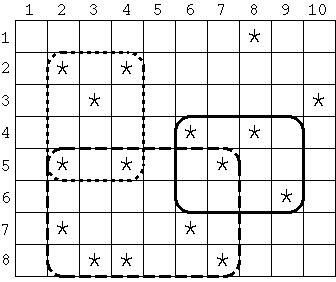Description

Input
Output
Sample Input
16 10 8 2 2 2 5 2 7 3 3 3 8 4 2 4 5 4 8 6 4 6 7 7 5 7 8 8 1 8 4 9 6 10 3 4 3 8 6 4 1 2 2 1 2 4 3 4 4 2 5 3 6 1 6 2 3 2 0
Sample Output
4 3
大致题意:国王所在的领地有W*H个点,其中n个点处有树, 现在领地上最多允许圈(当然可以少于)大小为S*T的矩形,问最多可圈中多少棵树?
解题思路:枚举起点,用二维树状数组求解。
枚举起点时要注意从行列从S和T开始,直到W和H为止。
用二维树状数组时,要注意update()每次更新时,c[ ] 加的是1。
AC代码:
#include <cstdio>
#include <cstring>
#include <algorithm>
using namespace std;
const int maxn = 102;
int n, w, h, s, t;
int c[maxn][maxn];
int lowbit(int x){ return x&(-x); }
void update(int x,int y){
for(int i=x; i<maxn; i+=lowbit(i))
for(int j=y; j<maxn; j+=lowbit(j))
c[i][j] ++;
}
long long sum(int x, int y){
long long ans = 0;
for(int i=x; i>0; i-=lowbit(i))
for(int j=y; j>0; j-=lowbit(j))
ans += c[i][j];
return ans;
}
int main(){
#ifndef ONLINE_JUDGE
freopen("in.txt", "r", stdin);
#endif
int x, y;
while(~scanf("%d", &n) && n){
scanf("%d%d", &w, &h);
memset(c,0,sizeof(c));
for(int i=1; i<=n; i++){
scanf("%d%d", &x, &y);
update(x, y);
}
scanf("%d%d", &s, &t);
long long ans = 0;
for(int i=s; i<=w; i++) //枚举起点
for(int j=t; j<=h; j++)
ans = max(ans, sum(i, j) - sum(i-s, j) - sum(i, j-t) + sum(i-s, j-t)); //树状数组求区域和
printf("%lld\n", ans);
}
return 0;
}
POJ 2029 Get Many Persimmon Trees (二维树状数组)
原文:http://blog.csdn.net/u013446688/article/details/39755313